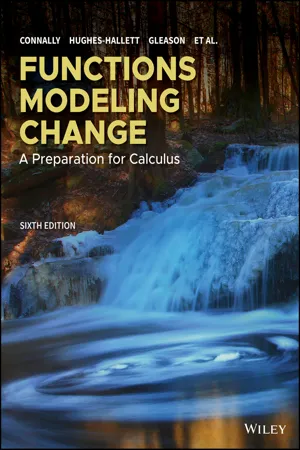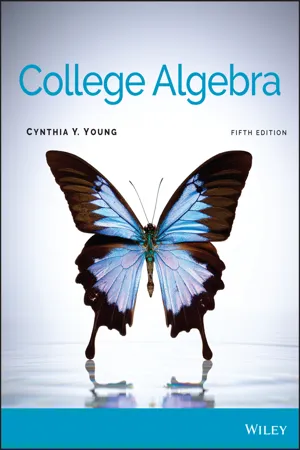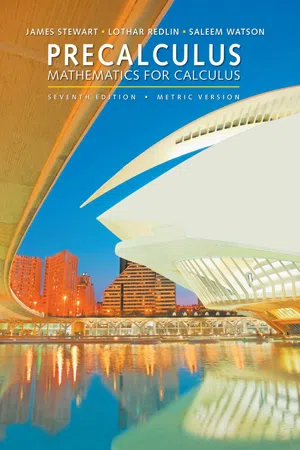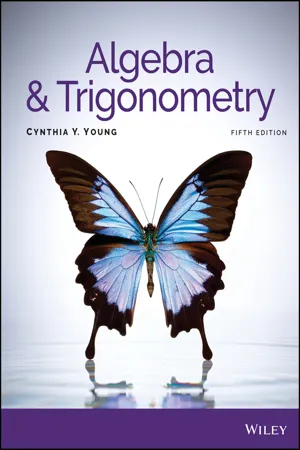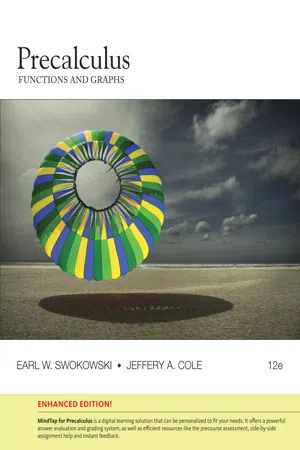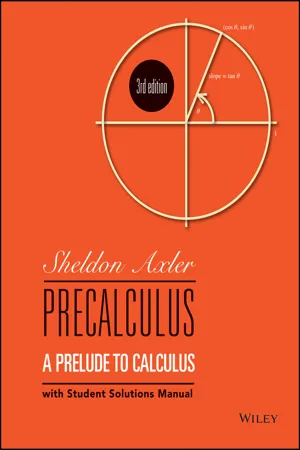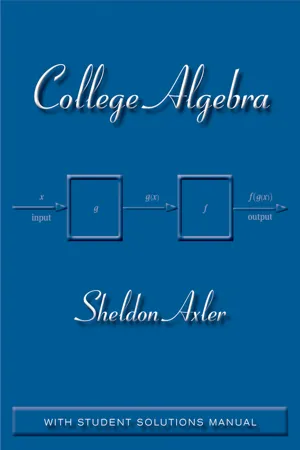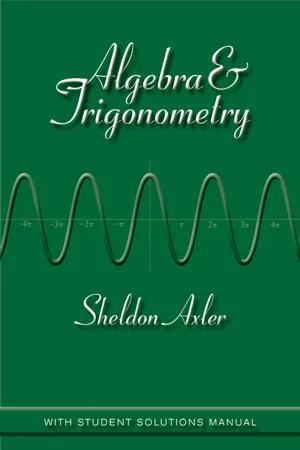Mathematics
Arithmetic Series
An arithmetic series is the sum of the terms in an arithmetic sequence. In an arithmetic series, each term is obtained by adding a constant difference to the previous term. The sum of the first n terms of an arithmetic series can be calculated using a formula involving the first term, the last term, and the number of terms.
Written by Perlego with AI-assistance
Related key terms
1 of 5
12 Key excerpts on "Arithmetic Series"
- No longer available |Learn more
- Alfred Basta, Stephan DeLong, Nadine Basta, , Alfred Basta, Stephan DeLong, Nadine Basta(Authors)
- 2013(Publication Date)
- Cengage Learning EMEA(Publisher)
6.2 A RITHMETIC S EQUENCES The Definition of an Arithmetic Sequence We’ve already mentioned that a sequence is an ordered progression of real num-bers that may or may not follow a prescribed pattern. If the order is changed, the sequence is changed, so the order of those numbers is fixed once it has been established. Let’s consider a particular type of sequence whose terms follow a specific sort of pattern. The pattern will probably be evident, but we’ll point it out to ensure clarity. { a n } 5 {4, 9, 14, 19, . . .} The terms of the sequence happen to satisfy the condition that they increase by a particular constant value (in this case, 5) from term to term. Such a sequence is called an arithmetic sequence . The emphasis in the word “arithmetic” is on the “met” fragment rather than the “rith” you may be used to using, so the pronunciation is “arith met ic sequence.” Copyright 2013 Cengage Learning. All Rights Reserved. May not be copied, scanned, or duplicated, in whole or in part. Due to electronic rights, some third party content may be suppressed from the eBook and/or eChapter(s). Editorial review has deemed that any suppressed content does not materially affect the overall learning experience. Cengage Learning reserves the right to remove additional content at any time if subsequent rights restrictions require it. Sequences and Series 223 The constant value that is the difference between the terms of an arithmetic sequence is, appropriately, referred to as the common difference for the terms of the sequence, and we say that the terms follow an arithmetic progression . A useful fact about such sequences is that they are completely determined by the value of the first term, a 1 , and the common difference, which we can refer to with the variable d . Let’s examine the terms of an arithmetic sequence a bit more closely by con-sidering the example already presented. - eBook - PDF
Functions Modeling Change
A Preparation for Calculus
- Eric Connally, Deborah Hughes-Hallett, Andrew M. Gleason(Authors)
- 2019(Publication Date)
- Wiley(Publisher)
A sequence can be thought of as a function whose domain is a set of integers. Each term of the sequence is an output value for the function, so = (). Example 3 List the first five terms of the sequence = (), where () = 500 − 10. Solution Evaluate () for = 1, 2, 3, 4, 5: 1 = (1) = 500 − 10 ⋅ 1 = 490 and 2 = (2) = 500 − 10 ⋅ 2 = 480. Similarly, 3 = 470, 4 = 460, and 5 = 450. Arithmetic Sequences You buy a used car that has already been driven 15,000 miles and drive it 8000 miles per year. The odometer registers 23,000 miles 1 year after your purchase, 31,000 miles after 2 years, and so on. The yearly odometer readings form a sequence whose terms are 15,000, 23,000, 31,000, 39,000, … . 1 www.statista.com/statistics/201182/forecast-of-smartphone-users-in-the-us/, accessed March 15, 2017. 13.1 SEQUENCES 13-3 Each term of the sequence is obtained from the previous term by adding 8000; that is, the difference between successive terms is 8000. A sequence in which the difference between pairs of successive terms is a fixed quantity is called an arithmetic sequence. Example 4 Which of the following sequences are arithmetic? (a) 9, 5, 1, −3, −7 (b) 3, 6, 12, 24, 48 (c) 2, 2 + , 2 + 2, 2 + 3 (d) 10, 5, 0, 5, 10 Solution (a) Each term is obtained from the previous term by subtracting 4. This sequence is arithmetic. (b) This sequence is not arithmetic: each term is twice the previous term. The differences are 3, 6, 12, 24. (c) This sequence is arithmetic: is added to each term to obtain the next term. (d) This is not arithmetic. The difference between the second and first terms is −5, but the difference between the fifth and fourth terms is 5. We can write a formula for the general term of an arithmetic sequence. Look at the sequence 2, 6, 10, 14, 18, …, in which the terms increase by 4, and observe that 1 = 2 2 = 6 = 2 + 1 ⋅ 4 3 = 10 = 2 + 2 ⋅ 4 4 = 14 = 2 + 3 ⋅ 4. - eBook - PDF
Intermediate Algebra
Connecting Concepts through Applications
- Mark Clark, Cynthia Anfinson(Authors)
- 2018(Publication Date)
- Cengage Learning EMEA(Publisher)
An arithmetic sequence is a linear function with a domain restricted to the natural numbers. Common Difference The common difference d for an arithmetic sequence is the constant amount that each term differs from the previous term. d 5 a n 2 a n 2 1 or d 5 a n 1 1 2 a n Copyright 2019 Cengage Learning. All Rights Reserved. May not be copied, scanned, or duplicated, in whole or in part. Due to electronic rights, some third party content may be suppressed from the eBook and/or eChapter(s). Editorial review has deemed that any suppressed content does not materially affect the overall learning experience. Cengage Learning reserves the right to remove additional content at any time if subsequent rights restrictions require it. C H A P T E R 1 0 S e q u e n c e s a n d S e r i e s 822 For each unit change in the input 1 n2 , the output changes by d. Recall that for a linear function, this common difference is called the slope. Example 4 Finding the common difference Determine whether or not each sequence is arithmetic. If the sequence is arithmetic, find the common difference d. a. 210, 25, 0, 5, 10, 15, . . . b. 25, 10, 35, 50, 115, . . . SOLUTION a. To determine whether or not the sequence is arithmetic, first determine whether the terms of the sequence follow a linear pattern. Compute the difference between each term and the preceding term. If the difference is common (the same), then the sequence is arithmetic (linear). a 2 2 a 1 5 1 252 2 1 2102 5 5 a 3 2 a 2 5 0 2 1 252 5 5 a 4 2 a 3 5 5 2 0 5 5 a 5 2 a 4 5 10 2 5 5 5 a 6 2 a 5 5 15 2 10 5 5 The common difference d 5 5 is constant, and therefore, the sequence is arithmetic. Another method to determine whether or not the sequence is arithmetic is to graph the terms as in Example 3. If the points follow a linear pattern, then the sequence is arithmetic. - eBook - PDF
- Doug French(Author)
- 2004(Publication Date)
- Continuum(Publisher)
Attempting to remember the complicated form without understanding its structure is much more difficult and is not necessary, even when it comes to solving a typical rather formal problem. For example, suppose that we are asked to find the last term in an Arithmetic Series whose sum is 222, with a first term of 2 and a common difference of 3. To do this we need to find and solve an equation to give the number of terms in the series which can be done as shown below: The last, or nth, term Mean term Sum of first n terms Equation for sum: Solving the equation: The only sensible solution is n = 12, since the number of terms must be a positive whole number, and so, by substituting into 3n - 1, the last term is 35. Arithmetic sequences and series are essentially very simple to understand and use if the necessary formulae are presented in a simple, possibly verbal, form which can be related easily to numerical examples. The procedure above has been designed to make each step towards the solution meaningful in itself, and easy to check. A blind substitution of numbers into a complicated looking formula may lead straight to the equation of the fourth line, but greater insight is obtained by leading up to it in the way shown. When students are confident with ideas they can modify and abbreviate their approach to problems, but for many it is better to use a slightly lengthier argument whose components are understood than a shorter one that relies just on memorized results. GEOMETRIC SEQUENCES AND SERIES Starting a new topic with a problem and letting students arrive at key results for themselves is potentially more motivating and can make them more memorable. The pocket money problem is one way of introducing some of the ideas of geometric sequences and series. The plan is for students to propose to their parents a plausible sounding pocket money scheme that turns out to be very rewarding. - eBook - PDF
- Cynthia Y. Young(Author)
- 2021(Publication Date)
- Wiley(Publisher)
81. An alternating sequence cannot be an arithmetic sequence. 82. The common difference of an arithmetic sequence is always positive. 722 CHAPTER 9 Sequences, Series, and Probability 9.3 Geometric Sequences and Series SKILLS OBJECTIVES • Determine if a sequence is geometric. • Find the general, nth, term of a geometric sequence. • Evaluate finite geometric series and infinite geometric series (if possible). CONCEPTUAL OBJECTIVES • Understand that the common ratio of a geometric sequence can be positive or negative. • Derive the formula for the nth term of a geometric sequence in terms of n, the first term of the sequence, and the common ratio. • Understand why it is not possible to evaluate all infinite geometric series. 9.3.1 Geometric Sequences 9.3.1 Skill Determine if a sequence is geometric. 9.3.1 Conceptual Understand that the common ratio of a geometric sequence can be positive or negative. In Section 9.2, we discussed arithmetic sequences, where successive terms had a common difference. In other words, each term was found by adding the same constant to the previous term. In this section we discuss geometric sequences, where successive terms have a common ratio. In other words, each term is found by multiplying the previous term by the same constant. The sequence 4, 12, 36, 108, . . . is geometric because each successive term is found by multiplying the previous term by 3. 83. Find the sum a + (a + b) + (a + 2b) + · · · + (a + nb). 84. Find the sum ∑ k=−29 30 ln e k . 85. The wave number, v (reciprocal of wave length), of certain light waves in the spectrum of light emitted by hydrogen is given by v = R ( 1 _ k 2 − 1 _ n 2) , n > k, where R = 109,678. A series of lines is given by holding k constant and varying the value of n. Suppose k = 2 and n = 3, 4, 5, . . . . Find the limit of the wave number of the series. 86. In a certain arithmetic sequence a 1 = − 4 and d = 6. - eBook - PDF
- James Stewart, Lothar Redlin, Saleem Watson, , James Stewart, Lothar Redlin, Saleem Watson(Authors)
- 2015(Publication Date)
- Cengage Learning EMEA(Publisher)
Show that the number of gifts received on the 12th day is a partial sum of an arithmetic sequence. Find this sum. DISCUSS ■ DISCOVER ■ PROVE ■ WRITE 78. DISCUSS: Arithmetic Means The arithmetic mean (or average) of two numbers a and b is m a b 2 Note that m is the same distance from a as from b , so a , m , b is an arithmetic sequence. In general, if m 1 , m 2 , . . . , m k are equally spaced between a and b so that a , m 1 , m 2 , . . . , m k , b is an arithmetic sequence, then m 1 , m 2 , . . . , m k are called k arithmetic means between a and b . (a) Insert two arithmetic means between 10 and 18. (b) Insert three arithmetic means between 10 and 18. (c) Suppose a doctor needs to increase a patient’s dosage of a certain medicine from 100 mg to 300 mg per day in five equal steps. How many arithmetic means must be inserted between 100 and 300 to give the progression of daily doses, and what are these means? 8.3 GEOMETRIC SEQUENCES ■ Geometric Sequences ■ Partial Sums of Geometric Sequences ■ What Is an Infinite Series? ■ Infinite Geometric Series In this section we study geometric sequences. This type of sequence occurs frequently in applications to finance, population growth, and other fields. ■ Geometric Sequences Recall that an arithmetic sequence is generated when we repeatedly add a number d to an initial term a . A geometric sequence is generated when we start with a number a and repeatedly multiply by a fixed nonzero constant r . DEFINITION OF A GEOMETRIC SEQUENCE A geometric sequence is a sequence of the form a , ar , ar 2 , ar 3 , ar 4 , . . . The number a is the first term , and r is the common ratio of the sequence. The n th term of a geometric sequence is given by a n ar n 1 Copyright 2016 Cengage Learning. All Rights Reserved. May not be copied, scanned, or duplicated, in whole or in part. Due to electronic rights, some third party content may be suppressed from the eBook and/or eChapter(s). - No longer available |Learn more
- James Stewart, Lothar Redlin, Saleem Watson(Authors)
- 2016(Publication Date)
- Cengage Learning EMEA(Publisher)
In general, if m 1 , m 2 , . . . , m k are equally spaced between a and b so that a, m 1 , m 2 , . . . , m k , b is an arithmetic sequence, then m 1 , m 2 , . . . , m k are called k arithmetic means between a and b. (a) Insert two arithmetic means between 10 and 18. (b) Insert three arithmetic means between 10 and 18. (c) Suppose a doctor needs to increase a patient’s dosage of a certain medicine from 100 mg to 300 mg per day in five equal steps. How many arithmetic means must be inserted between 100 and 300 to give the progression of daily doses, and what are these means? 12.3 GEOMETRIC SEQUENCES ■ Geometric Sequences ■ Partial Sums of Geometric Sequences ■ What Is an Infinite Series? ■ Infinite Geometric Series In this section we study geometric sequences. This type of sequence occurs frequently in applications to finance, population growth, and other fields. ■ Geometric Sequences Recall that an arithmetic sequence is generated when we repeatedly add a number d to an initial term a. A geometric sequence is generated when we start with a number a and repeatedly multiply by a fixed nonzero constant r. DEFINITION OF A GEOMETRIC SEQUENCE A geometric sequence is a sequence of the form a, ar, ar 2 , ar 3 , ar 4 , . . . The number a is the first term, and r is the common ratio of the sequence. The nth term of a geometric sequence is given by a n ar n1 Copyright 2017 Cengage Learning. All Rights Reserved. May not be copied, scanned, or duplicated, in whole or in part. Due to electronic rights, some third party content may be suppressed from the eBook and/or eChapter(s). Editorial review has deemed that any suppressed content does not materially affect the overall learning experience. Cengage Learning reserves the right to remove additional content at any time if subsequent rights restrictions require it. SECTION 12.3 ■ Geometric Sequences 859 The number r is called the common ratio because the ratio of any two consecutive terms of the sequence is r. - eBook - PDF
- Cynthia Y. Young(Author)
- 2021(Publication Date)
- Wiley(Publisher)
S 15 = 15 __ 2 (87 − 3) = 630 This is incorrect. What mistake was made? 79. An arithmetic sequence and a finite Arithmetic Series are the same. 80. The sum of all infinite and finite Arithmetic Series can always be found. 81. An alternating sequence cannot be an arithmetic sequence. 82. The common difference of an arithmetic sequence is always positive. 12.3 Geometric Sequences and Series 1133 12.3 Geometric Sequences and Series SKILLS OBJECTIVES • Determine if a sequence is geometric. • Find the general, nth, term of a geometric sequence. • Evaluate finite geometric series and infinite geometric series (if possible). CONCEPTUAL OBJECTIVES • Understand that the common ratio of a geometric sequence can be positive or negative. • Derive the formula for the nth term of a geometric sequence in terms of n, the first term of the sequence, and the common ratio. • Understand why it is not possible to evaluate all infinite geometric series. 12.3.1 Geometric Sequences 12.3.1 Skill Determine if a sequence is geometric. 12.3.1 Conceptual Understand that the common ratio of a geometric sequence can be positive or negative. In Section 12.2, we discussed arithmetic sequences, where successive terms had a common difference. In other words, each term was found by adding the same constant to the previous term. In this section we discuss geometric sequences, where successive terms have a common ratio. In other words, each term is found by multiplying the previous term by the same constant. The sequence 4, 12, 36, 108, . . . is geometric because each successive term is found by multiplying the previous term by 3. 83. Find the sum a + (a + b) + (a + 2b) + · · · + (a + nb). 84. Find the sum ∑ k=−29 30 ln e k . 85. The wave number, v (reciprocal of wave length), of certain light waves in the spectrum of light emitted by hydrogen is given by v = R ( 1 _ k 2 − 1 _ n 2) , n > k, where R = 109,678. A series of lines is given by holding k constant and varying the value of n. - eBook - PDF
Precalculus
Functions and Graphs, Enhanced Edition
- Earl Swokowski, Jeffery Cole(Authors)
- 2016(Publication Date)
- Cengage Learning EMEA(Publisher)
Cengage Learning reserves the right to remove additional content at any time if subsequent rights restrictions require it. 9.2 Arithmetic Sequences 653 is a (finite) arithmetic sequence, then are k arithmetic means between the numbers a and b . The process of determining these numbers is referred to as inserting k arithmetic means between a and b. Inserting arithmetic means Insert three arithmetic means between 2 and 9. SOLUTION We wish to find three real numbers , and such that the following is a (finite) arithmetic sequence: We may regard this sequence as an arithmetic sequence with first term and fifth term . To find the common difference d , we may proceed as follows: let in and solve for d Thus, the arithmetic means are ■ An application of an arithmetic sequence A carpenter wishes to construct a ladder with nine rungs whose lengths decrease uniformly from 24 inches at the base to 18 inches at the top. Determine the lengths of the seven intermediate rungs. SOLUTION The ladder is sketched in Figure 2. The lengths of the rungs are to form an arithmetic sequence with and . Hence, we need to insert seven arithmetic means between 18 and 24. Using with , , and gives us or, equivalently, Hence, , and the intermediate rungs have lengths (in inches) ■ It is sometimes desirable to express a sum in terms of summation nota-tion, as illustrated in the next example. Expressing a sum in summation notation Express in terms of summation notation: 1 4 2 9 3 14 4 19 5 24 6 29 E X A M P L E 7 18.75, 19.5, 20.25, 21, 21.75, 22.5, and 23.25. d 6 8 0.75 8 d 6. 24 18 8 d a 9 24 a 1 18 n 9 a n a 1 n 1 d a 9 24 a 1 18 a 1 , a 2 , . . . , a 9 E X A M P L E 6 c 3 c 2 d 22 4 7 4 29 4 . c 2 c 1 d 15 4 7 4 22 4 11 2 c 1 a 1 d 2 7 4 15 4 d 7 4 a 1 2 a 5 9 9 2 4 d a n a 1 n 1 d n 5 a 5 a 1 5 1 d a 5 9 a 1 2 2, c 1 , c 2 , c 3 , 9 c 3 c 1 , c 2 E X A M P L E 5 c 1 , c 2 , . . . , c k FIGURE 2 a 1 18 a 9 24 a 2 a 3 a 4 a 5 a 6 a 7 a 8 Copyright 2017 Cengage Learning. - eBook - PDF
Precalculus
A Prelude to Calculus
- Sheldon Axler(Author)
- 2016(Publication Date)
- Wiley(Publisher)
61 Show that the sum of an arithmetic sequence with n terms, first term b, and difference d between consecutive terms is n b + (n - 1)d 2 . 62 Restate the symbolic version of the formula for evaluating an Arithmetic Series using summation notation. 63 Restate the symbolic version of the formula for evaluating a geometric series using summation notation. 64 Use technology to find a formula for the sum of the first n cubes 1 + 8 + 27 + · · · + n 3 . 65 Use technology to find a formula for the sum of the first n fourth powers 1 + 16 + 81 + · · · + n 4 . 66 For n = 0, 1, 2, 3, 4, 5, show that the sum of the entries in row n + 1 of Pascal’s triangle equals 2 n . 67 Show that n ∑ k=0 n! k!(n - k)! = 2 n for every positive integer n. [Hint: Expand (1 + 1) n using the Binomial Theorem.] 68 Suppose n is a positive integer. Show that the sum of the entries in row n + 1 of Pascal’s triangle equals 2 n . [Hint: Use the result from the previous problem.] 69 Explain why 999 ∑ m=1 (m 5 - 2m + 7) = 999 ∑ k=1 (k 5 - 2k + 7). 70 Explain why 1000 ∑ m=1 m 2 = 999 ∑ m=0 (m 2 + 2m + 1). Worked-Out Solutions to Odd-Numbered Exercises In Exercises 1–10, evaluate the Arithmetic Series. 1 1 + 2 + 3 + · · · + 98 + 99 + 100 solution This series contains 100 terms. The average of the first and last terms in this series is 1+100 2 , which equals 101 2 . Thus 1 + 2 + · · · + 99 + 100 equals 100 · 101 2 , which equals 50 · 101, which equals 5050. 3 302 + 305 + 308 + · · · + 6002 + 6005 + 6008 solution The difference between consecutive terms in this series is 3. We need to determine the number n of terms in this series. Using the formula for the terms of an arithmetic sequence, we have 302 + (n - 1)3 = 6008. Subtracting 302 from both sides of this equation gives the equation (n - 1)3 = 5706; dividing both sides by 3 then gives n - 1 = 1902. Thus n = 1903. The average of the first and last terms in this series is 302+6008 2 , which equals 3155. - eBook - PDF
- Sheldon Axler(Author)
- 2011(Publication Date)
- Wiley(Publisher)
In Exercises 35–38, write the series using summa- tion notation (starting with k = 1). Each series in Exercises 35–38 is either an Arithmetic Series or a geometric series. 35. 2 + 4 + 6 + · · · + 100 solution The k th term of this sequence is 2k. The last term corresponds to k = 50. Thus 2 + 4 + 6 + · · · + 100 = 50 X k=1 2k. 37. 5 9 + 5 27 + 5 81 + · · · + 5 3 40 solution The k th term of this sequence is 5 3 k+1 . The last term corresponds to k = 39 (be- cause when k = 39, the expression 5 3 k+1 equals 5 3 40 ). Thus 5 9 + 5 27 + 5 81 + · · · + 5 3 40 = 39 X k=1 5 3 k+1 . 39. Restate the symbolic version of the formula for evaluating an Arithmetic Series using summa- tion notation. solution Consider an Arithmetic Series with n terms, with an initial term b, and with dif- ference d between consecutive terms. The k th term of this series is b + (k - 1)d. Thus the for- mula for evaluating an Arithmetic Series using summation notation is n X k=1 ( b + (k - 1)d ) = n ( b + (n-1)d 2 ) . This could also be written in the form n-1 X k=0 ( b + kd ) = n ( b + (n-1)d 2 ) . For Exercises 41–44, consider the fable from the beginning of Section 5.4. In this fable, one grain of rice is placed on the first square of a chess- board, then two grains on the second square, then four grains on the third square, and so on, dou- bling the number of grains placed on each square. 41. Find the total number of grains of rice on the first 18 squares of the chessboard. solution The total number of grains of rice on the first 18 squares of the chessboard is 1 + 2 + 4 + 8 + · · · + 2 17 . This is a geometric series; the ratio of consecu- tive terms is 2. The term that would follow the last term is 2 18 . Thus the sum of this series is 1 - 2 18 1 - 2 , which equals 2 18 - 1. 43. Find the smallest number n such that the total number of grains of rice on the first n squares of the chessboard is more than 30,000,000. - eBook - PDF
- Sheldon Axler(Author)
- 2011(Publication Date)
- Wiley(Publisher)
In Exercises 35–38, write the series using summa- tion notation (starting with k = 1). Each series in Exercises 35–38 is either an Arithmetic Series or a geometric series. 35. 2 + 4 + 6 + · · · + 100 solution The k th term of this sequence is 2k. The last term corresponds to k = 50. Thus 2 + 4 + 6 + · · · + 100 = 50 k=1 2k. 37. 5 9 + 5 27 + 5 81 + · · · + 5 3 40 solution The k th term of this sequence is 5 3 k+1 . The last term corresponds to k = 39 (be- cause when k = 39, the expression 5 3 k+1 equals 5 3 40 ). Thus 5 9 + 5 27 + 5 81 + · · · + 5 3 40 = 39 k=1 5 3 k+1 . 39. Restate the symbolic version of the formula for evaluating an Arithmetic Series using summa- tion notation. solution Consider an Arithmetic Series with n terms, with an initial term b, and with dif- ference d between consecutive terms. The k th term of this series is b + (k - 1)d. Thus the for- mula for evaluating an Arithmetic Series using summation notation is n k=1 ( b + (k - 1)d ) = n ( b + (n-1)d 2 ) . This could also be written in the form n-1 k=0 ( b + kd ) = n ( b + (n-1)d 2 ) . For Exercises 41–44, consider the fable from the beginning of Section 5.4. In this fable, one grain of rice is placed on the first square of a chess- board, then two grains on the second square, then four grains on the third square, and so on, dou- bling the number of grains placed on each square. 41. Find the total number of grains of rice on the first 18 squares of the chessboard. solution The total number of grains of rice on the first 18 squares of the chessboard is 1 + 2 + 4 + 8 + · · · + 2 17 . This is a geometric series; the ratio of consecu- tive terms is 2. The term that would follow the last term is 2 18 . Thus the sum of this series is 1 - 2 18 1 - 2 , which equals 2 18 - 1. 43. Find the smallest number n such that the total number of grains of rice on the first n squares of the chessboard is more than 30,000,000.
Index pages curate the most relevant extracts from our library of academic textbooks. They’ve been created using an in-house natural language model (NLM), each adding context and meaning to key research topics.

